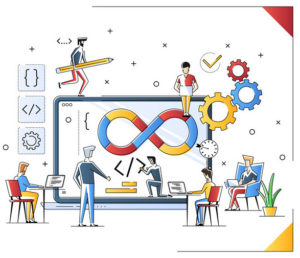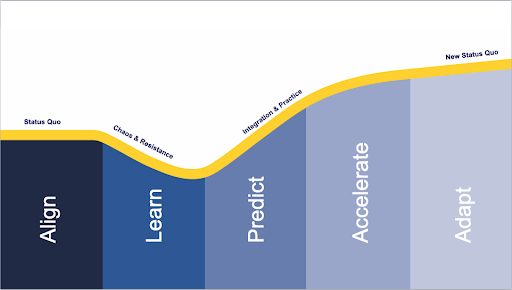
You Keep Using Those Words…
When you hear “Business Outcomes,” “DevOps,” and/or Agile Transformation” – what comes to mind?
We’ll share our definitions. (If you disagree with our interpretations, contact us…we love a good exchange of ideas!)
Business Outcomes
It’s more than outputs.
These are the highest-level objectives of your organization. The big WHY. They are key inputs for your business and technology discussions around WHAT to work on. They are measurable outcomes – goal posts – that provide feedback on HOW your initiatives are doing.
DevOps
It’s more than continuous delivery.
DevOps is the practice of software development (Dev) engineers and of IT operations (Ops) working together during a product’s entire lifecycle, from design through development to production support, in order to shorten the total lead time (from concept to cash) and to provide predictable delivery of high-quality products.
Agile
It’s more than “Scrum.”
Agile is an iterative approach that focuses on collaboration, customer feedback, and small, rapid releases in order to satisfy the customer through early and continuous delivery of value. While the Agile movement originated in software development, it has been applied to much more: from medical devices to spacecraft, as well as engineering, marketing, and education.
Agile Transformation
It’s more than “Training, Titles, Ceremonies, and Tools.”
It doesn’t come in a box (or inside a cloud). It ain’t a silver bullet.
An Agile Transformation is a rethinking and reworking of how your organization engages technology, people, and processes to achieve specific business outcomes. It is the relentless pursuit of continuous improvement.
What’s the Pay Off?
Agile Transformations and DevOps initiatives are complementary. Can you have one without the other? Sure. However, if you put the two together you have the opportunity to align the tech side of the house with the business side. This combination will enable your enterprise to gain faster feedback, reduce risks while also obtaining meaningful business outcomes.
We’ve identified nine common business outcomes, all of which are positively influenced by Agile+DevOps. (Reference: Harvard Business Review Analytic Services Survey, Sept 2018).
In our experience leadership tends to “Want them all, equally. And NOW” Sorry. If everything is important, you know the saying, nothing is. Prioritization of the organization’s highest-level objectives, to avoid whiplash and to create focus, should narrow the field down to no more than three.
You then can measure the impact of your transformation initiatives against the top outcomes, providing actionable qualitative and quantitative data. (For more on metrics, see Metrics in Agile: How to Effectively Measure Your Transformation Journey)
| Employee Engagement | Employees are more satisfied in their work, willing to go the extra mile, passionate about the purpose of their jobs, and committed to the organization. |
| Customer Satisfaction | Customers are satisfied with the experience, benefits, and outcomes when using your product or service. |
| Quality | The product or service meets the expectations of the market for usability, reliability, etc. |
| Speed | The time it takes to deliver an idea into the market. |
| Predictability | Teams maintain a predictable cadence of delivery enabling the business to make informed business decisions. |
| Innovation | New ideas, creative thoughts, or novel imaginations provide better solutions to meet new requirements, unarticulated needs, or known market needs. |
| Market Responsiveness | The ability of the organization to pivot quickly to respond to ever-changing market demands. |
| Productivity | Increase the business value realized while maintaining or reducing costs. |
| Continuous Improvement | The ability of the organization to relentlessly pursue optimizations in all aspects of business functions. |
(We’ve got a poster summary of these business outcomes that you can download from here.)
What to Expect…
It will be challenging as there are many potential impediments that could derail the transformation without the right support.
From organizational silos to legacy technology. From the need to ensure security and compliance, to the lack of the right skills and even the right mindsets among employees.
The good news is that there’s a path through. For over a decade, Agile Velocity has been helping enterprises chart and benchmark their progress during change initiatives. We’ve observed patterns of change, learning, and growth that move through five different stages, each building on the learnings from the previous stage. The Align stage is the first stage of the journey while Adapt requires a significant amount of agile maturity.
| Align | Align the initiative with measurable business outcomes and define a clear transformation roadmap. |
| Learn | Establish foundational practices and a culture of learning by empowering teams to take ownership of their work and process. |
| Predict | Maintain a predictable cadence of delivery, enabling organizations to make informed business decisions. |
| Accelerate | Optimize the full value stream and shorten the time-to-market. |
| Adapt | Embrace organization-wide adaptability in order to quickly respond to market demands. |
For software powered organizations (we could make the argument that 99% of all businesses fit this description), DevOps can significantly improve their ability to progress through the latter stages of Predict, Accelerate and Adapt.

Science has proven that introducing change into any system will result in a period of chaos until a new status quo is achieved. When adopting DevOps practices or undergoing an Agile Transformation, organizations will experience a temporary decrease in performance before integrating new practices enables a new, more performant, status quo.
Many leaders don’t acknowledge or plan for the “dip” that accompanies the learning stage – adding more change, producing more chaos, resulting in failed initiatives. Any organizational change must have leadership support along the entire journey or it will be short-lived or fail outright. With leadership support and by using the stages as a guide, time spent in “chaos” can be reduced.
Transformation Leadership – Where to Lean In
In their book Accelerate: The Science of Lean Software and DevOps: Building and Scaling High Performing Technology Organizations, Nicole Forsgren, Jez Humble, and Gene Kim discuss the role of leadership and call it out as one of the more overlooked topics in transformation.
Like the authors, we believe that “Leadership really does have a powerful impact on results. . . . A good leader affects a team’s ability to deliver … how the team manages its work and develops products. All of these have a measurable impact on an organization’s profitability, productivity, and market share. These also have an impact on customer satisfaction, efficiency, and the ability to achieve organizational goals.”
Some of the key transformation elements which require leadership involvement include:
Sense of Urgency
- Identifying and communicating the compelling reason(s) why the organization should change
- Ensuring alignment around the compelling purpose has been achieved at all levels
Roll Out Strategy
- Defining an initial transformation roadmap, one that takes into account organization structure demands, top risks, and incremental rollouts
- Aligning teams to value
Enabling Action
- Facilitating change to support the overall transformation
- Resolving organizational obstacles and impediments with urgency
- Continuing to communicate the change vision (rinse and repeat)
Cultural Shifts
All transformations require shifts in culture and mindset. How big? The standard answer: “It depends!” Some situational variables are current organizational levels of
- Agile Architecture (vs monolithic, tightly coupled systems)
- Slack/Learning Time (vs emphasis on 100% “resource” utilization)
- Automation – Testing and Integration (vs over the wall or manual)
- Tolerance for Experimentation and Failure (vs perfection and/or blame seeking)
- Ability to Measure with Actionable Metrics (vs vanity metrics or zero data gathering)
For more see Leadership Skills for the New Normal.
How Agile Velocity Can Help
Many organizations attempt transformations with disappointing results. If you perceive a gap between where your organization is and where you want it to be, we can help. Our client roster is filled with Fortune 500 companies and growing businesses alike – all of whom have benefited from our expertise.
We’ll help you shorten your feedback loops – so you can build the right thing, the right way, for the right people, at just the right time.
Our Services Include:
- Enterprise Agile Transformations
- Adaptive Leadership Support
- Organization Assessment
- Transformation Roadmapping
- Consulting
- Agile Training
Take the next step in your journey – contact us today.
Read More
- Accelerate: The Science of Lean Software and DevOps (Book)
- 8 Common Pitfalls of An Agile Transformation (White Paper)
- What to Expect When You’re Expecting An Agile Transformation (Webinar Recording)
- The DevOps Handbook (Book)
- Unicorn Project (Book)
- Leading the Transformation: Applying Agile and DevOps Principles at Scale (Book)



